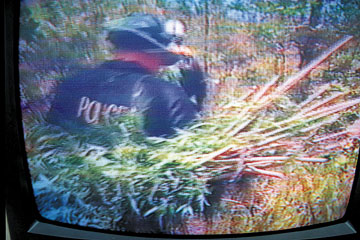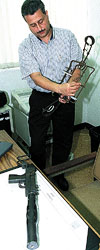"All I'm saying is: 'Is there a better way to deal with this terrible problem of illegal drug use?" Big Island county councilman Curtis Taylor
"It's the law that creates the problem. People wouldn't be growing pot in the national park or in the sugar cane fields or on anybody else's land if it was legal ... Green Harvest is the biggest industry the police have going today. It gives them an excuse to not deal with real crime." Aaron Anderson, Big Island advocate for legalization of hemp and marijuana for medical purposes |

In a video highlighting Green Harvest operations, police carry marijuana plants capable of producing pounds of marijuana. Even though growers are turning to smaller plants that can be easily hidden, Police still find plants the size of small trees. Big Island Police Video
“Puna Butter. Stoney mother. There is no other.” — Chant describing Puna-grown marijuana. The Maui Wowee, Kona Gold and Puna Butter smuggled out of the Islands has always been accorded a certain mystique in marijuana lore. “The perception is that Hawaii continues to produce some of the most legendary, quality pot in the country,” said Steven Wishnia, senior editor at High Times Magazine, a 200,000-circulation magazine devoted to the marijuana culture. No one disputes that Green Harvest cut into the industry. But it also drove up the price of pakalolo, from $25 an ounce in the 1970s to $400 today, and as much as $600 if it’s smuggled from the Big Island to Maui, Kauai or Oahu.
Even in the shadows, it was impossible not to see the look of self-satisfaction that spread across his gaunt, unlined face. The grower leaned back in his chair and admired the ounce of cannabis sativa laid out before him. It was the result of cross-breeding small, quick-growing plants in pots he can move quickly to avoid detection. His guerrilla style represents the modern era in Hawaii’s war on marijuana. “Today,” the grower said, “it’s duck-and-cover.” The next day, nearly 20 miles away in Puna’s Hawaiian Paradise Park, Big Island vice detectives Burt Shimabukuro and Benton Bolos rappelled out of a Hughes 500 helicopter and into a grove of ohia trees to ruin some other grower’s day. In less than five minutes, Shimabukuro and Bolos had slid out of the helicopter, cut 110 2-foot pakalolo plants with their machetes, and flown off in search of more clandestine patches. “In and out, just like that,” said Big Island vice Lt. Henry Tavares, who is in charge of marijuana eradication for the eastern half of Hawaii County. As growers have spread smaller plants over miles of other peoples’ land, police have responded by traveling in three helicopters: one that spots marijuana and two that carry five officers each who remove the plants. Traveling lighter means they can move quicker and cover miles of terrain. “We taught the growers our methods,” Tavares said. “Now we’re adapting, too.”
|
|||||||||||||||||||||||||||||||||||||||||||||||||
